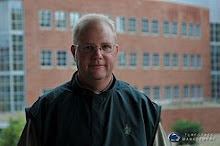Last year I decided that it was time for a change in my life. I have been involved in the golf industry from 1983 to 1995, then again from 2003 to 2006, and finally in the landscaping industry since 1996 when I opened my own business. For the past couple of years, I gave much thought to re-entering the golf industry. This time, however, I did not want to end up working at just any ordinary course. I wanted to take it to the next level, but how to get there became the question to answer. My search began after doing some research about the turfgrass program at Penn State. Last March after meeting with Dr. John Kaminski at his office on the Penn State main campus, I decided that this might be an excellent way to re-enter the golf course profession. We discussed course work and the internship as well as his plan to achieve my ultimate goal of being a superintendent at a championship golf course. Penn State’s Golf Course Turfgrass Management Program is known around the world as being a leader in educating the best and brightest turfgrass managers. Having the largest turfgrass science alumni base in the world provides a wonderful support system as well as networking opportunities that no other school can match. Making the decision to return to school and enter the Golf Course Turfgrass Management Program at Penn State soon became a much easier decision after hearing all the attributes of the Penn State Program.
Part of the plan that we developed included volunteering at several major tournament events in order to begin building my network of influential individuals within the turfgrass industry. We decided on two major events last year: the 2009 U.S. Women’s Open held at Saucon Valley Country Club and the 2009 Walker Cup held at Merion Golf Club. Through these opportunities, I met many assistants, superintendents, industry representatives, and USGA officials who were all very eager to offer advice to help me navigate my way through these early years of my professional career.
Part of the plan that we developed included volunteering at several major tournament events in order to begin building my network of influential individuals within the turfgrass industry. We decided on two major events last year: the 2009 U.S. Women’s Open held at Saucon Valley Country Club and the 2009 Walker Cup held at Merion Golf Club. Through these opportunities, I met many assistants, superintendents, industry representatives, and USGA officials who were all very eager to offer advice to help me navigate my way through these early years of my professional career.
Building an influential network is a process that takes an entire career. In addition to picking the right turf school and volunteering at major events, successful networking can be achieved in many other ways including:
- Start with your friends. Use them to add to your group by having them introduce you to others.
- Go to where industry leaders might be such as trade shows, conferences, and university turf field days. Meet as many individuals as you can. Hand out business cards and collect them. Ask questions by participating in conference classes. Introduce yourself to as many industry leaders as possible.
- Start a Blog. Follow a Blog. Be an active participant so that people take notice.
- Write an article in an industry journal or magazine.
- Join professional organizations such as the GCSAA as well as state and local industry groups.
- Talk to university faculty and fellow alumni.
While attending conferences or volunteering at tournaments, remember that you are always being watched by someone who could be your future employer. Maintain a professional demeanor at all times. Remember that you only have one chance to make a first impression.
- Dress appropriately for the event and always make sure that you are well groomed.
- Be positive. People do not like to be around negative individuals.
- Be friendly, polite, and attentive to those around you.
- Know how to start and end a conversation.
- Have a good handshake.
- Practice techniques to remember names.
- Show enthusiasm and be helpful.
Remember that trust developed between individuals within a network is not something that is automatically given; it is something that must be earned over time through hard work, determination, and a mutual respect for the other individuals in the network.
Networking opportunities are all around us. Keep your eyes and ears open as you never know who might be there. Use every means available to make contacts including conferences, trade shows, volunteering, professional organizations, the internet, trade journals, university faculty, fellow alumni, and most importantly your friends. Networking is a two way street. It is not just about meeting new people who can potentially help your career in the future, but also about how you can help others achieve their personal and professional goals.





Great post!
ReplyDelete